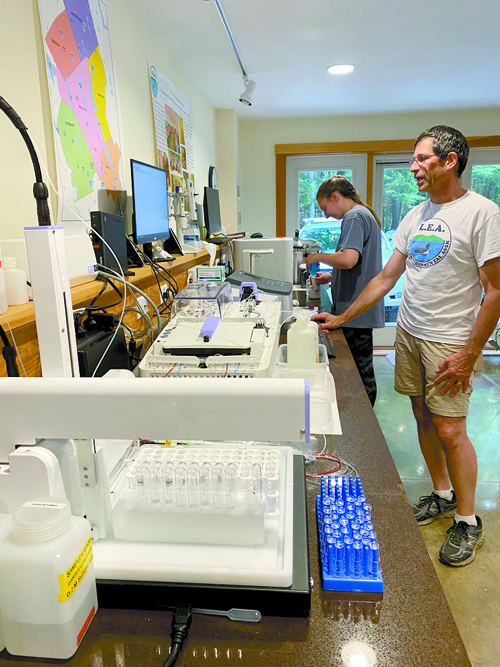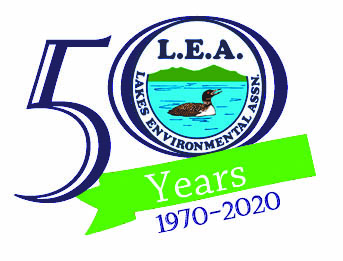LEA celebrates 50 years of lake service

By Peter Lowell
Guest Writer
Through the generosity of foundations and donors, the Lakes Environmental Association has been able to build a premier lake lab and testing program at its Maine Lake Science Center to analyze lake water quality and warn of impending problems.
The Lake Region and Maine are fortunate to have this resource, because all Maine lakes are extremely fragile and face mounting threats to their quality.
As the previous executive director of LEA, I have seen the organization grow immensely over time, and the Science Center is no exception. Ten years ago, it was just an idea. Today, it houses dedicated staff and amazing field and lab technology. On a recent trip to the Center, I got a tour of some of the new instruments and was once again impressed by how far LEA has come.
On one piece of equipment, the robotic arm travels over rows of test tubes filled with lake water samples and selects the next in line. A sipper tube lowers to extract the exact amount of liquid, which will make a marvelous trip through modern science. The sample is pumped into a tiny, segmented glass pipe. At strategic points along the way, air bubbles and chemical reagents are introduced to gradually mix and tint the sample. In the final step, the sample passes through a colorimeter, which uses the sample’s color to determine its phosphorus concentration in parts per billion. The phosphorus test is one of the most important indicators of lake health — waters containing as little as 15 parts per billion (the mathematical equivalent of 45 seconds in an entire century) can fuel algae blooms.

A little further down the lab bench is a FlowCam, another amazing piece of scientific technology. This device also sends a sample through a glass tube. But instead of tinting it, it takes a photo of every particle it detects microscopically. As the sample passes by the camera, photos of the objects begin to pop up on the monitor. These magical, tiny plants and animals make up the base of the lake’s food web and can turn the lake green if too much phosphorus is available to feed them. Some can even be toxic in high concentrations. A diverse mix of these tiny creatures and plants is ideal, because when individual species dominate the community, it is a sign that things are out of equilibrium.
Other remarkable “bench” instruments measure chlorophyll (the green pigment in plants) to determine algal density, check acidity, or measure light absorbance in samples. An oven, water purification system, and balance help prepare samples for analysis.
In the field, automated sensing is king. Large yellow buoys hold a chain of sensors that extend into the deepest waters of Highland Lake and Long Lake. These electronically “read” oxygen, temperature, clarity, and chlorophyll in the water column at various depths. Readings travel to the solar-powered data logger, which sends the information by cellular network to the LEA computer base every 15 minutes. Data and live graphs are then posted online at mainelakes.org.
Another instrument, called a sonde, is like a portable buoy system able to measure pH, temperature, chlorophyll, oxygen, conductivity (relates to hardness), and phycocyanin (a pigment specific to algae that can be toxic) wherever it goes.
This impressive array of tools complements the routine oxygen/temperature probes and Secchi disks (used to determine water clarity) that have been in use in Maine for decades.
Although equipment is crucial, human resources have been the key to growing capacity and knowledge. LEA began comprehensive lake testing in 1970 when it hired researcher Dr. Robert Cuillo from Nason College. The next year, Dr. Robert Chute from Bates College took over the testing program with student interns. Bob Chute was a founder of LEA, along with his brother Phil from Naples. Almost 50 years later, LEA developed the Maine Lake Science Center and recruited Dr. Ben Peierls in 2017 to head Maine’s first facility dedicated to lake studies. When I visited, Ben and intern Hanna Holden from St. Joseph’s College were analyzing samples in the lake lab. This year, they have been working as a team with student interns Shannon Nelligan (Unity College) and Erin Antosh (University of Tampa), and LEA researcher Maggie Welch, assisted by educators Alanna Doughty and Mary Jewett to study 41 lakes.
The Center is the culmination of decades of scientific advancements and collaborations, all aimed at saving Maine’s cherished lakes. With the advent of the Center, LEA organized annual retreats that brought together researchers from all over the state to share information and ideas. What came from this venture was a coordinated protection plan for Maine lakes, a better understanding of the threats facing our waters, and the best technologies available for monitoring these threats.
Because the Maine Lake Science Center is a working lab, tours of the facility are limited and need to be set up in advance with Alyson Smith (alyson@mainelakes.org) or by calling 207-647-3318.
If you are interested in finding out more about the Science Center and its initiatives, please visit LEA’s website at mainelakes.org.
You can also become an LEA member on the website and support all of the resources the Maine Lake Science Center and LEA provide for the Lake Region and Maine.

